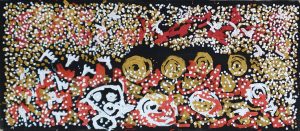Australian Aboriginal Artists | A - Z
Australian Aboriginal Art
Australian Aboriginal Artists
Aboriginal art is a rich tapestry, reflecting Australia’s Indigenous peoples’ profound cultural and spiritual connection to their land and heritage. This art form is not merely decorative but serves as a means of storytelling, cultural expression, and connection to the Dreamtime – the Aboriginal understanding of the world, its creation, and its spiritual significance.
The roots of Aboriginal art history trace back over 60,000 years, making it one of the oldest continuous artistic traditions in the world. Traditional Aboriginal art encompasses a diverse range of mediums, including rock paintings, bark paintings, ceremonial body paintings, sand art, and sculptures. These artworks often depict ancestral stories, creation myths, totemic symbols, and the natural world, embodying the deep spiritual beliefs and cultural practices of Aboriginal communities.
Rock art is one of Australia’s most enduring Aboriginal art forms in caves, cliffs, and rock shelters. These ancient artworks, often painted using natural pigments, depict hunting scenes, Dreamtime stories, and intricate geometric designs. The motifs and symbols found in rock art serve as a visual language, conveying cultural knowledge and spiritual teachings from one generation to the next.
Bark painting is another significant tradition in Aboriginal art history, particularly among Indigenous communities in Arnhem Land. Using materials sourced from the natural environment, such as tree bark, ochre pigments, and natural resins, artists create intricate designs that convey stories of ancestral beings, landforms, and sacred rituals. Each painting is imbued with layers of meaning, reflecting the artist’s connection to their ancestral lands and cultural identity.
Ceremonial body painting is integral to many Aboriginal ceremonies and rituals, serving as a form of spiritual expression and cultural identity. These intricate body designs, often created using natural pigments and clay, symbolize the connection between the individual, their community, and the Dreamtime. Through body painting, Aboriginal people reaffirm their cultural traditions, honour their ancestors, and maintain their spiritual connection to the land.
In contemporary times, Aboriginal art has undergone a renaissance, gaining recognition and acclaim on the global stage. Indigenous artists draw upon traditional techniques and motifs while exploring new mediums and styles to express their cultural identity and engage with contemporary issues. From vibrant acrylic paintings to intricate dot paintings, contemporary Aboriginal art continues to evolve, reflecting the resilience and creativity of Indigenous communities in the face of ongoing social, political, and environmental challenges.
In conclusion, Aboriginal art history is a testament to Australia’s Indigenous peoples’ enduring cultural heritage and spiritual connection. Aboriginal artists preserve ancient traditions, celebrate their cultural identity, and share their profound connection to the land and the Dreamtime with the world through art. As custodians of this rich artistic legacy, it is essential to recognize and honour the significance of Aboriginal art in shaping Australia’s cultural landscape and fostering greater understanding and respect for Indigenous cultures.
Australian Aboriginal Artists have a very diverse range of artworks today. While maintaining traditional art forms, they are also experimenting, and their art is constantly evolving.












































































